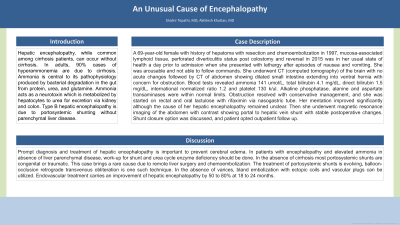Back


Poster Session D - Tuesday Morning
Category: Liver
D0537 - An Unusual Cause of Encephalopathy
Tuesday, October 25, 2022
10:00 AM – 12:00 PM ET
Location: Crown Ballroom

Has Audio

Shalini Tripathi, MD
CarolinaEast Medical Center
new bern, NC
Presenting Author(s)
Shalini Tripathi, MD1, Akhilesh Khuttan, MD2
1CarolinaEast Medical Center, New Bern, NC; 2University of Iowa, Coralville, IA
Introduction: Hepatic encephalopathy, while common among cirrhosis patients, can occur without cirrhosis. In adults, 90% cases of hyperammonemia are due to cirrhosis. Ammonia is central to its pathophysiology produced by bacterial degradation in the gut from protein, urea, and glutamine. Ammonia acts as a neurotoxin which is metabolized by hepatocytes to urea for excretion via kidney and colon. Type B hepatic encephalopathy is due to portosystemic shunting without parenchymal liver disease.
Case Description/Methods: A 69-year-old female with history of hepatoma with resection and chemoembolization in 1997, mucosa-associated lymphoid tissue, perforated diverticulitis status post colostomy and reversal in 2015 was in her usual state of health a day prior to admission when she presented with lethargy after episodes of nausea and vomiting. She was arousable and not able to follow commands. Her CT (computed tomography) of the brain with no acute changes followed by CT of abdomen showing dilated small intestine extending into ventral hernia with concern for obstruction. Blood tests revealed ammonia 141 umol/L, total bilirubin 4.1 mg/dL, direct bilirubin 1.5 mg/dL, international normalized ratio 1.2 and platelet 130 k/ul. Alkaline phosphatase, alanine and aspartate transaminases were within normal limits. Obstruction resolved with conservative management and she was started on rectal and oral lactulose with rifaximin via nasogastric tube. Her mentation improved significantly although the cause of her hepatic encephalopathy remained unclear. Then she underwent magnetic resonance imaging of the abdomen with contrast showing portal to hepatic vein shunt with stable postoperative changes. Shunt closure option was discussed and patient opted outpatient follow up.
Discussion:
Disclosures:
Shalini Tripathi, MD1, Akhilesh Khuttan, MD2. D0537 - An Unusual Cause of Encephalopathy, ACG 2022 Annual Scientific Meeting Abstracts. Charlotte, NC: American College of Gastroenterology.
1CarolinaEast Medical Center, New Bern, NC; 2University of Iowa, Coralville, IA
Introduction: Hepatic encephalopathy, while common among cirrhosis patients, can occur without cirrhosis. In adults, 90% cases of hyperammonemia are due to cirrhosis. Ammonia is central to its pathophysiology produced by bacterial degradation in the gut from protein, urea, and glutamine. Ammonia acts as a neurotoxin which is metabolized by hepatocytes to urea for excretion via kidney and colon. Type B hepatic encephalopathy is due to portosystemic shunting without parenchymal liver disease.
Case Description/Methods: A 69-year-old female with history of hepatoma with resection and chemoembolization in 1997, mucosa-associated lymphoid tissue, perforated diverticulitis status post colostomy and reversal in 2015 was in her usual state of health a day prior to admission when she presented with lethargy after episodes of nausea and vomiting. She was arousable and not able to follow commands. Her CT (computed tomography) of the brain with no acute changes followed by CT of abdomen showing dilated small intestine extending into ventral hernia with concern for obstruction. Blood tests revealed ammonia 141 umol/L, total bilirubin 4.1 mg/dL, direct bilirubin 1.5 mg/dL, international normalized ratio 1.2 and platelet 130 k/ul. Alkaline phosphatase, alanine and aspartate transaminases were within normal limits. Obstruction resolved with conservative management and she was started on rectal and oral lactulose with rifaximin via nasogastric tube. Her mentation improved significantly although the cause of her hepatic encephalopathy remained unclear. Then she underwent magnetic resonance imaging of the abdomen with contrast showing portal to hepatic vein shunt with stable postoperative changes. Shunt closure option was discussed and patient opted outpatient follow up.
Discussion:
Prompt diagnosis and treatment of hepatic encephalopathy is important to prevent cerebral edema. In patients with encephalopathy and elevated ammonia in absence of liver parenchymal disease, work-up for shunt and urea cycle enzyme deficiency should be done. In the absence of cirrhosis most portosystemic shunts are congenital or traumatic. This case brings a rare cause due to remote liver surgery and chemoembolization. The treatment of portosystemic shunts is evolving, balloon-occlusion retrograde transvenous obliteration is one such technique. In the absence of varices, bland embolization with ectopic coils and vascular plugs can be utilized. Endovascular treatment carries an improvement of hepatic encephalopathy by 50 to 80% at 18 to 24 months.
Disclosures:
Shalini Tripathi indicated no relevant financial relationships.
Akhilesh Khuttan indicated no relevant financial relationships.
Shalini Tripathi, MD1, Akhilesh Khuttan, MD2. D0537 - An Unusual Cause of Encephalopathy, ACG 2022 Annual Scientific Meeting Abstracts. Charlotte, NC: American College of Gastroenterology.
